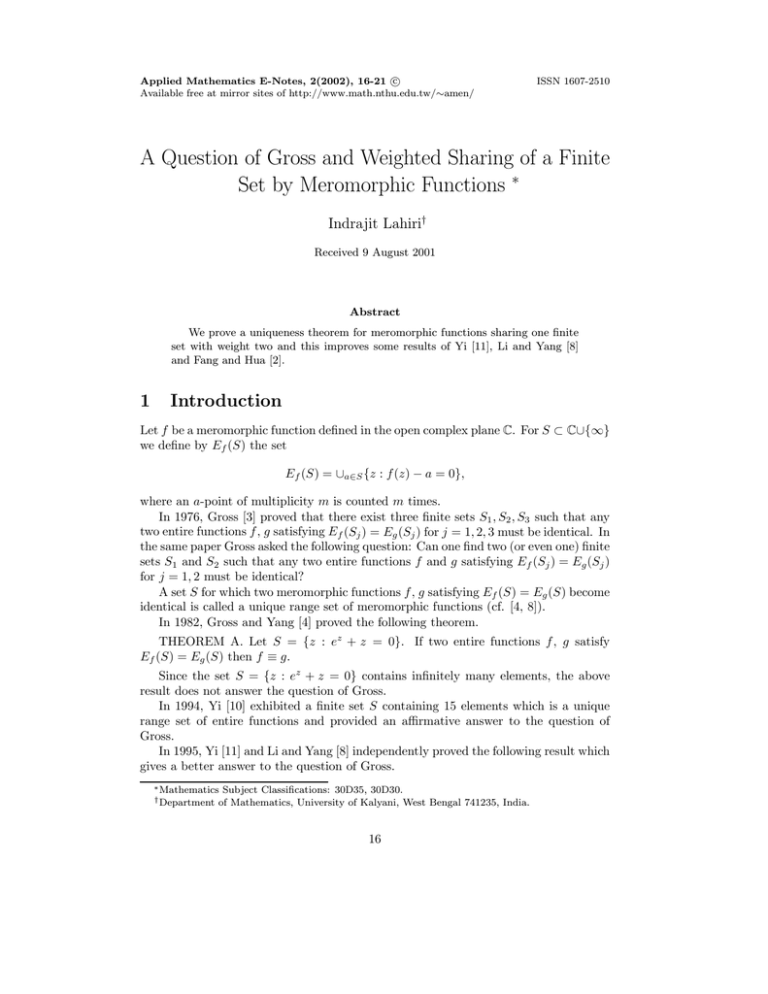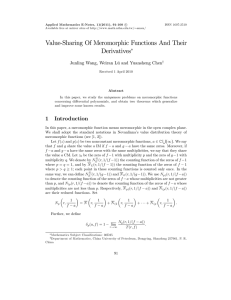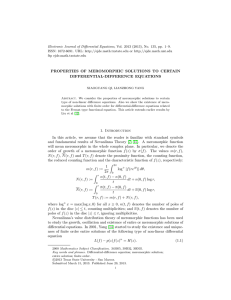Document 10677157
advertisement

Applied Mathematics E-Notes, 2(2002), 16-21 c
Available free at mirror sites of http://www.math.nthu.edu.tw/∼amen/
ISSN 1607-2510
A Question of Gross and Weighted Sharing of a Finite
Set by Meromorphic Functions ∗
Indrajit Lahiri†
Received 9 August 2001
Abstract
We prove a uniqueness theorem for meromorphic functions sharing one finite
set with weight two and this improves some results of Yi [11], Li and Yang [8]
and Fang and Hua [2].
1
Introduction
Let f be a meromorphic function defined in the open complex plane C. For S ⊂ C∪{∞}
we define by Ef (S) the set
Ef (S) = ∪a∈S {z : f (z) − a = 0},
where an a-point of multiplicity m is counted m times.
In 1976, Gross [3] proved that there exist three finite sets S1 , S2 , S3 such that any
two entire functions f , g satisfying Ef (Sj ) = Eg (Sj ) for j = 1, 2, 3 must be identical. In
the same paper Gross asked the following question: Can one find two (or even one) finite
sets S1 and S2 such that any two entire functions f and g satisfying Ef (Sj ) = Eg (Sj )
for j = 1, 2 must be identical?
A set S for which two meromorphic functions f , g satisfying Ef (S) = Eg (S) become
identical is called a unique range set of meromorphic functions (cf. [4, 8]).
In 1982, Gross and Yang [4] proved the following theorem.
THEOREM A. Let S = {z : ez + z = 0}. If two entire functions f , g satisfy
Ef (S) = Eg (S) then f ≡ g.
Since the set S = {z : ez + z = 0} contains infinitely many elements, the above
result does not answer the question of Gross.
In 1994, Yi [10] exhibited a finite set S containing 15 elements which is a unique
range set of entire functions and provided an affirmative answer to the question of
Gross.
In 1995, Yi [11] and Li and Yang [8] independently proved the following result which
gives a better answer to the question of Gross.
∗ Mathematics
† Department
Subject Classifications: 30D35, 30D30.
of Mathematics, University of Kalyani, West Bengal 741235, India.
16
I. Lahiri
17
THEOREM B. Let S = {z : z 7 − z 6 − 1 = 0}. If two entire functions f, g satisfy
Ef (S) = Eg (S) then f ≡ g.
Extending Theorem B to meromorphic functions, recently Fang and Hua [2] proved
the following theorem.
THEOREM C. Let S = {z : z 7 − z 6 − 1 = 0}. If two meromorphic functions f , g
are such that Θ(∞; f ) > 11/12, Θ(∞; g) > 11/12 and Ef (S) = Eg (S) then f ≡ g.
Here Θ is the ramification index which is defined below.
In [6, 7] the notion of weighted sharing is introduced which we explain in the
following definition.
DEFINITION 1. Let k be a nonnegative integer or infinity. For a ∈ C ∪ {∞}, we
denote by Ek (a; f ) the set of all a-points of f where an a-point of multiplicity m is
counted m times if m ≤ k, and k + 1 times if m > k. If Ek (a; f ) = Ek (a; g), we say
that f and g share the value a with weight k.
The definition implies that if f , g share a value a with weight k then z0 is a zero
of f − a with multiplicity m(≤ k) if and only if it is a zero of g − a with multiplicity
m(≤ k), and z0 is a zero of f − a with multiplicity m(> k) if and only if it is a zero of
g − a with multiplicity n(> k) where m is not necessarily equal to n.
We say that f , g share (a, k) if f , g share the value a with weight k. Clearly if f ,
g share (a, k) then f , g share (a, p) for all integer p which satisfies 0 ≤ p < k. Also we
note that f , g share a value a IM (ignoring multiplicity) or CM (counting multiplicity)
if and only if f , g share (a, 0) or (a, ∞) respectively.
DEFINITION 2. For S ⊂ C ∪{∞}, we define Ef (S, k) as Ef (S, k) = ∪a∈S Ek (a; f ),
where k is a nonnegative integer or infinity.
The above definition is in [6]. Clearly Ef (S) = Ef (S, ∞).
DEFINITION 3. A set S for which two meromorphic functions f, g satisfying
Ef (S, k) = Eg (S, k) becomes identical is called a unique range set of weight k for
meromorphic functions.
Unless stated otherwise, throughout the paper f and g are two nonconstant meromorphic functions. We now explain some basic definitions and notations of the value
distribution theory (see e.g. [5]). We denote by n(r, f ) the number of poles of f in
|z| ≤ r, where a pole is counted according to its multiplicity, and by n(r, f ) the number
of distinct poles of f in |z| ≤ r. Also we put
] r
n(t, f ) − n(0, f )
dt + n(0, f ) log r,
N (r, f ) =
t
0
and
N (r, f ) =
]
0
r
n(t, f ) − n(0, f )
dt + n(0, f ) log r.
t
The quantities N (r, f ), N (r, f ) are called respectively the counting function and reduced counting function of poles of f . Let
m(r, f ) =
1
2π
]
2π
0
log+ | f (reiθ ) | dθ,
18
A Question of Gross
where log+ x = log x if x ≥ 1 and log+ x = 0 if 0 ≤ x < 1. We call m(r, f ) the
proximity function of f . The sum T (r, f ) = m(r, f ) + N (r, f ) is called the Nevanlinna
characteristic function of f . If a is a finite complex number, we put
1
1
1
m(r, a; f ) = m r,
, N (r, a; f ) = N r,
, N (r, a; f ) = N r,
.
f −a
f −a
f −a
The quantity
Θ(a; f ) = 1 − lim sup
r−→∞
N (r, a; f )
T (r, f )
is called the ramification index, where a ∈ C ∪ {∞} and N (r, ∞; f ) = N (r, f ). By the
second fundamental
S theorem we know that the set {a : a ∈ C ∪ {∞}, Θ(a; f ) > 0} is
countable and a Θ(a; f ) ≤ 2. Finally we denote by N2 (r, a; f ) the counting function
of a-points of f where an a-point of multiplicity m is counted m times if m ≤ 2 and is
counted twice if m > 2 (see e.g. [1]).
In this paper we prove the following theorem which improves Theorem B and Theorem C.
THEOREM 1. Let S = {z : z 7 −z 6 −1 = 0}. If f and g satisfy Θ(∞; f )+Θ(∞; g) >
3/2 and Ef (S, 2) = Eg (S, 2), then f ≡ g.
2
Preparatory Lemmas
In this section we present some lemmas which will be required to prove our main
Theorem. The first one is in [9].
Sn
j
LEMMA 1. Let P (f ) =
j=0 aj f , where a0 , a1 , . . . , an (≡ 0) are such that
T (r, aj ) = S(r, f ) for j = 0, 1, . . . , n. Then T (r, P (f )) = nT (r, f ) + S(r, f ).
LEMMA 2. If Θ(∞; f )+Θ(∞; g) > 3/2, then for n ≥ 3, f n−1 (f −1)g n−1 (g−1) ≡ 1.
PROOF. Assume to the contrary that
f n−1 (f − 1)g n−1 (g − 1) ≡ 1.
(1)
Suppose f does not have any pole. Then from (1) it follows that g has no zero nor
1-point. So by the deficiency relation we get Θ(∞; g) = 0, which contradicts the given
condition. So the lemma is proved in this case. Similarly we can prove the lemma when
g does not have any pole. Now we suppose that f and g have poles. From (1), we see
that if z0 is a zero of f with multiplicity p then z0 is a pole of g with multiplicity q such
that p(n − 1) = nq, i.e., p = qn/(n − 1). Since n, p, q are all positive integers, it follows
that p ≥ n. Hence Θ(0; f ) ≥ 1 − 1/n. Again from (1), we see that if z0 is an 1-point
of f with multiplicity p then z0 is a pole of g with multiplicity q such that p = nq and
so p ≥ n. Hence Θ(1; f ) ≥ 1 − 1/n. Similarly we can prove that Θ(0; g) ≥ 1 − 1/n and
Θ(1; g) ≥ 1 − 1/n. So by the deficiency relation we get
Θ(0; f ) + Θ(1; f ) + Θ(0; g) + Θ(1; g) + Θ(∞; f ) + Θ(∞; g) ≤ 4,
or,
4(1 −
1
3
) + ≤ 4,
n
2
I. Lahiri
19
or n ≤ 8/3, a contradiction. This proves the lemma.
LEMMA 3. If Θ(∞; f ) + Θ(∞; g) > 3/2, then for n ≥ 4, f n−1 (f − 1) ≡ g n−1 (g − 1)
implies f ≡ g.
PROOF. Let
f n−1 (f − 1) ≡ g n−1 (g − 1).
(2)
Assume to the contrary that f ≡ g. Then from (2) we get
f ≡1−
y n−1
,
1 + y + + · · · + y n−1
(3)
y2
where y = g/f . If y is constant then y = 1. Also from (2) we see that y n = 1 and
y n−1 = 1 and so (2) implies
1 − y n−1
f≡
1 − yn
which is a contradiction because f is nonconstant. Let y be nonconstant. From (3) we
get by the first fundamental theorem and Lemma 1 that
T (r, f ) = T (r,
n−1
[
j=0
1
1
) + S(r, y) = (n − 1)T (r, ) + S(r, y)
j
y
y
= (n − 1)T (r, y) + S(r, y).
Now we note that any pole of y is not a pole of 1 − y n−1 /
follows that
n−1
[
N (r, uk ; y) ≤ N (r, ∞; f ),
Sn−1
j=1
y j . So from (3) it
k=1
where uk = exp(2kπi/n) for k = 1, 2, . . . , n − 1. By the second fundamental theorem
we get
(n − 3)T (r, y) ≤
n−1
[
N (r, uk ; y) + S(r, y)
k=1
≤ N (r, ∞; f ) + S(r, y)
< (1 − Θ(∞; f ) + ε)T (r, f ) + S(r, y)
= (n − 1)(1 − Θ(∞; f ) + ε)T (r, y) + S(r, y), (4)
where ε > 0.
Again putting y1 = 1/y, noting that T (r, y) = T (r, y1 ) + O(1) and proceeding as
above we get
(n − 3)T (r, y) ≤ (n − 1)(1 − Θ(∞; g) + ε)T (r, y) + S(r, y),
where ε > 0. From (4) and (5) we get in view of the given condition,
2(n − 3)T (r, y)
≤ (n − 1)(2 − Θ(∞; f ) − Θ(∞; g) + 2ε)T (r, y) + S(r, y)
1
< (n − 1)( + 2ε)T (r, y) + S(r, y),
2
(5)
20
A Question of Gross
which implies a contradiction for all sufficiently small positive ε due to the assumption
that n ≥ 4. Hence f ≡ g.This completes the proof.
LEMMA 4. If f, g share (1, 2), then one of the following holds: (i) T (r) ≤
N2 (r, 0; f ) + N2 (r, 0; g) + N2 (r, ∞; f ) + N2 (r, ∞; g) + S(r, f )+S(r, g), where T (r) =
max{T (r, f ), T (r, g)}, (ii) f g ≡ 1, or, (iii) f ≡ g.
The proof can be found in [7].
3
Proof of Theorem
Let F = f 6 (f − 1) and G = g 6 (g − 1). Since Ef (S, 2) = Ef (S, 2), it follows that
F , G share (1, 2). Also by Lemma 1, we see that T (r, F ) = 7T (r, f ) + S(r, f ) and
T (r, G) = 7T (r, g) + S(r, g). Now
N2 (r, 0; F ) + N2 (r, 0; G) + N2 (r, ∞; G) + N2 (r, ∞; G) + S(r, F ) + S(r, G)
≤ 2N (r, 0; f ) + N2 (r, 0; f − 1) + 2N (r, 0; g)
+N2 (r, 0; g − 1) + 2N (r, ∞; f ) + 2N (r, ∞; g) + S(r, f ) + S(r, g)
≤ {6 + 2(2 − Θ(∞; f ) − Θ(∞; g) + ε)}T (r) + S(r, f ) + S(r, g)
= (10 − 2Θ(∞; f ) − 2Θ(∞; g) + 2ε)T (r) + S(r, f ) + S(r, g),
(6)
where ε > 0. Also we see that
max{T (r, F ), T (r, G)} = 7T (r) + S(r, f ) + S(r, g).
(7)
From (6) and (7), we see that
max{T (r, F ), T (r, G)}
≤ N2 (r, 0; F ) + N2 (r, 0; G) + N2 (r, ∞; F ) + N2 (r, ∞; G) + S(r, F ) + S(r, G)
if
7T (r) ≤ (10 − 2Θ(∞; f ) − 2Θ(∞; g) + 2ε)T (r) + S(r, f ) + S(r, g)
i.e., if
(2Θ(∞; f ) + 2Θ(∞; g) − 3 − 2ε)T (r) ≤ S(r, f ) + S(r, g).
Then a contradiction is reached for sufficiently small positive ε because Θ(∞; f ) +
Θ(∞; g) > 3/2. By Lemma 2, we see that F G ≡ 1 because Θ(∞; f ) + Θ(∞; g) > 3/2.
Hence applying Lemma 4, we see that F ≡ G and so by Lemma 3, we get f ≡ g. This
completes the proof.
References
[1] C. T. Chuang, Une généralisation d’une inégalité de Nevanlinna, Scientia Sinica
13(1964), 887-895.
[2] M. Fang and X. Hua, Meromorphic functions that share one finite set CM, Nanjing
Daxue Xuebao Shuxue Bannian Kan 15(1)(1998), 15-22.
I. Lahiri
21
[3] F. Gross, Factorization of meromorphic functions and some open problems, Complex Analysis (Proc. Conf. Univ. Kentucky, Lexington, Ky, 1976), pp. 51-69, Lecture notes in Math. Vol. 599, Springer-Berlin, 1977.
[4] F. Gross and C. C. Yang, On preimage range sets of meromorphic functions, Proc.
Japan Acad., 58(1982), 17-20.
[5] W. K. Hayman, Meromorphic Functions, Clarendon Press, Oxford 1964.
[6] I. Lahiri, Weighted sharing and uniqueness of meromorphic functions, Nagoya
Math. J., 161(2001), 193-206.
[7] I. Lahiri, Weighted value sharing and uniqueness of meromorphic functions, Complex Variables, to appear.
[8] P. Li and C. C. Yang, Some further results on the unique range sets of meromorphic
functions, Kodai Math. J., 13(1995), 437-450.
[9] C. C. Yang, On deficiencies of differential polynomials II, Math. Z., 125(1972),
107-112.
[10] H. X. Yi, On a problem of Gross, Sci. China Ser. A, 24(1994), 1134-1144.
[11] H. X. Yi, A question of Gross and the uniqueness of entire functions, Nagoya
Math. J., 138(1995), 169-177.
![Mathematics 414 2003–04 Exercises 5 [Due Monday February 16th, 2004.]](http://s2.studylib.net/store/data/010415766_1-b65af2bb66ab8e422354912dcedcb6a6-300x300.png)









